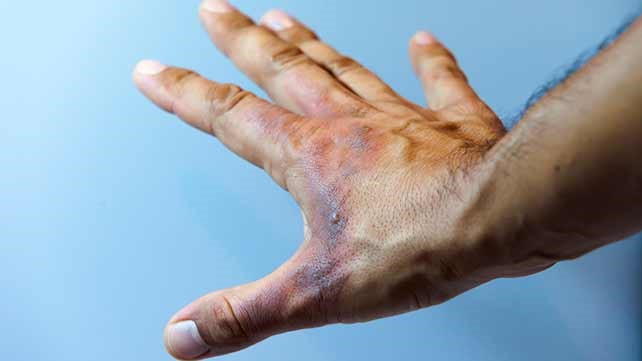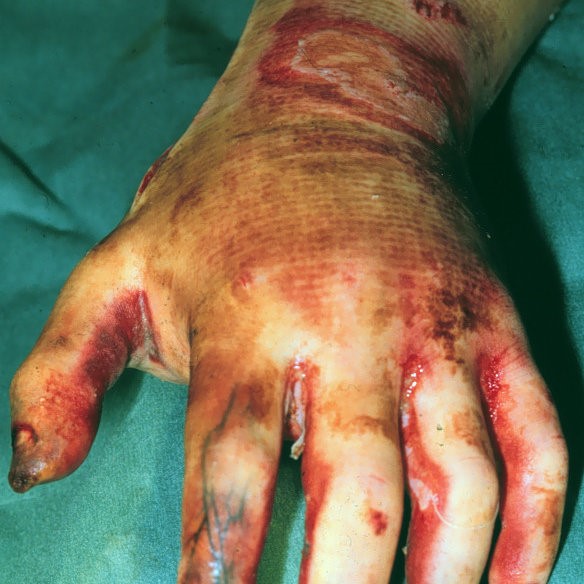Burn wounds
What are burns?
Burns are one of the most common household injuries, especially among children. The term “burn” means more than the burning sensation associated with this injury. Burns are characterized by severe skin damage that causes the affected skin cells to die.
Most people can recover from burns without serious health consequences, depending on the cause and degree of injury. More serious burns require immediate emergency medical care to prevent complications and death.
Burn levels
There are three primary types of burns: first-, second-, and third-degree. Each degree is based on the severity of damage to the skin, with first-degree being the most minor and third-degree being the most severe. Damage includes:
- first-degree burns: red, nonblistered skin
- second-degree burns: blisters and some thickening of the skin
- third-degree burns: widespread thickness with a white, leathery appearance
There are also fourth-degree burns. This type of burn includes all of the symptoms of a third-degree burn and also extends beyond the skin into tendons and bones.
Burns have a variety of causes, including:
- scalding from hot, boiling liquids
- chemical burns
- electrical burns
- fires, including flames from matches, candles, and lighters
- excessive sun exposure
The type of burn is not based on the cause of it. Scalding, for example, can cause all three burns, depending on how hot the liquid is and how long it stays in contact with the skin.
Chemical and electrical burns warrant immediate medical attention because they can affect the inside of the body, even if skin damage is minor.
First-degree burn
First-degree burns cause minimal skin damage. They are also called “superficial burns” because they affect the outermost layer of skin. Signs of a first-degree burn include:
- redness
- minor inflammation, or swelling
- pain
- dry, peeling skin occurs as the burn heals
Since this burn affects the top layer of skin, the signs and symptoms disappear once the skin cells shed. First-degree burns usually heal within 7 to 10 days without scarring.
You should still see your doctor if the burn affects a large area of skin, more than three inches, and if it’s on your face or a major joint, which include:
- knee
- ankle
- foot
- spine
- shoulder
- elbow
- forearm
First-degree burns are usually treated with home care. Healing time may be quicker the sooner you treat the burn. Treatments for a first-degree burn include:
- soaking the wound in cool water for five minutes or longer
- taking paracetamol or ibuprofen for pain relief
- applying lidocaine (an anaesthetic) with or Aloe vera gel or cream to reliefe the burning sensation
- using an antibiotic based oinment or paraffine gauze the affected area
Make sure you don’t use ice, as this may make the damage worse. Never apply cotton balls to a burn because the small fibers can stick to the injury and increase the risk of infection. Also, avoid home remedies like butter and eggs as these are not proven to be effective.
Second-degree burn
Second-degree burns are more serious because the damage extends beyond the top layer of skin. This type burn causes the skin to blister and become extremely red and sore.
Some blisters pop open, giving the burn a wet or weeping appearance. Over time, thick, soft, scab-like tissue called fibrinous exudate may develop over the wound.

Due to the delicate nature of these wounds, keeping the area clean and bandaging it properly is required to prevent infection. This also helps the burn heal quicker.
Deep second-degree burns can take longer than three weeks to heal, but most heal within two to three weeks without scarring, but often with pigment changes to the skin.
The worse the blisters are, the longer the burn will take to heal. In some severe cases, skin grafting is required to fix the damage. Skin grafting takes healthy skin from another area of the body and moves it to the site of the burned skin.
Treatments for a mild second-degree burn generally include:
- running the skin under cool water for 15 minutes or longer
- taking over-the-counter pain medication (acetaminophen or ibuprofen)
- applying wound moisturizing oinments
However, seek emergency medical treatment if the burn affects a widespread area, such as any of the following:
- face
- hands
- buttocks
- groin
- feet
Third-degree burn
Excluding fourth-degree burns, third-degree burns are the most severe. They cause the most damage, extending through every layer of skin.
There is a misconception that third-degree burns are the most painful. However, with this type of burn the damage is so extensive that there may not be any pain because of nerve damage.
Depending on the cause, the symptoms third-degree burns can exhibit include:
- waxy and white color
- char
- leathery aspect
- dark brown color
- raised and leathery texture
- blisters that do not develop
- non sensitive and do not bleed on superficial needle prick
Without surgery, these wounds heal with severe scarring and contracture. There is no set timeline for complete spontaneous healing for third-degree burns.

Treatment:
Third degree burns can be life threatening or function threatening.
Their management necessitate the intervention of an intensivist and a plastic surgeon. It’s an emergency, reaching a satisfactory result is a lengthy process and may necessitate multiple surgeries and procedures such us :
- debridement to remove dead tissue and prevent infection
- skin graft
- artificial skin graft
- flaps
- compression garments
- physiotherapy
- occupational therapy
- skin expansion to remove scars